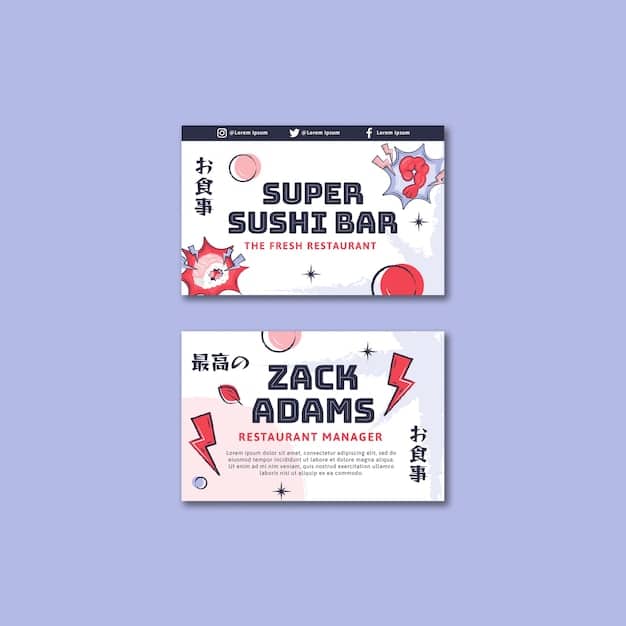Japanese Business Card Etiquette in 2025: 5 Mistakes to Avoid
Navigating Japanese business card etiquette in 2025 requires understanding the nuances of presentation, acceptance, and handling to avoid cultural missteps that could jeopardize business deals.
In the world of international business, mastering cultural nuances is paramount. When engaging with Japanese counterparts, understanding business card etiquette is not just polite—it’s essential. As we move into 2025, staying informed about these customs can be a deciding factor in sealing deals. Let’s explore the key mistakes to avoid when navigating Japanese business card etiquette in 2025.
Understanding the Importance of Meishi in Japanese Culture
The exchange of business cards, or “meishi,” is deeply ingrained in Japanese business culture. More than just a formality, it is a ritual that signifies respect and the establishment of a professional relationship. The meishi represents the individual and their company, and handling it with care demonstrates your understanding of Japanese values.
The Significance of the Meishi
In Japan, the business card serves as an extension of the person presenting it. The act of exchanging meishi is about establishing a connection and showing respect from the very first interaction. A meishi is treated with the same care that you would treat its owner. This careful handling sets the correct tone for all future dealings.
Why Etiquette Matters
Adhering to proper business card etiquette in Japan shows respect to Japanese business practices and facilitates a smooth and fruitful conversation. A business transaction is unlikely to be successful if a Japanese partner feels that you do not understand the importance of protocol. Proper etiquette acts as a shortcut for showing you are ready to communicate at the expected level with your counterparts.
- Respect: Following etiquette shows you respect Japanese culture.
- Trust: Proper handling of meishi can help you build trust in your business relationships.
- Professionalism: Adhering to etiquette portrays you as a professional who is serious about partnership.
Understanding Meishi’s importance will set the tone for any business interaction in Japan. It is critical therefore, not to take it lightly and to familiarize yourself with the correct rules and attitudes.
Mistake #1: Presenting or Receiving a Meishi Incorrectly
The most common misstep is botching the presentation or reception of a meishi. There’s a specific way to do it, and deviating from this can signal disrespect or a lack of preparation.

The Two-Handed Rule
Always present and receive a meishi with both hands. This demonstrates sincerity and respect. Using only one hand can come across as casual or even dismissive.
Card Orientation
Make sure the card is facing the recipient so they can read it right away. This shows you’re thoughtful and considerate of their convenience. It also indicates that you respect the information being conveyed.
To avoid this mistake, remember:
- Always use both hands.
- Ensure the card is facing the recipient correctly.
- Offer the card at chest level or slightly higher.
Perfecting the art of exchanging meishi properly is critical for shaping initial positive impressions in all business encounters.
Mistake #2: Immediately Pocketing the Meishi
Once you receive a meishi, what you do with it next is equally important. Immediately pocketing the card, without even glancing at it, is considered rude. This suggests disinterest in the person and their company.
The Art of Review
Take a moment to examine the card. Acknowledge the person’s name and title, and perhaps make a brief comment about the company or their role. This shows you value the information being shared which is important in the Japanese business environment.
The Right Place for Storage
Never put the meishi in your pocket, especially your back pocket. This implies carelessness. Instead, use a business card holder or place it carefully on the table in front of you during the meeting.
Consider these rules to avoid this mistake:
- Always review the card upon receiving it.
- Never immediately pocket the meishi.
- Use a cardholder or place it respectfully on the table.
Taking a brief moment to carefully review the card goes a long way toward building respect and camaraderie.
Mistake #3: Writing on a Meishi
Writing on a meishi in front of the person who gave it to you is a major faux pas. A meishi is treated as a representation of the person, so marking it is seen as defacing their identity.
Exceptions and Considerations
There might be situations where you need to add a note. However, do this discreetly and away from the giver’s presence. Write any additional notes on the reverse side to acknowledge the presentation of their business details from the front.
Alternatives
Instead of writing on the card, consider using a separate notepad to jot down any important details or reminders. This shows more respect for the meishi and the person who presented it.
Avoid this mistake using the following considerations:
- Never write on a meishi in the giver’s presence.
- Use a separate notepad for notes.
- Only write on the back once the giver is no longer present.
Preserving the pristine nature of a meishi reinforces your genuine respect for the card’s owner and their represented business.
Mistake #4: Running Out of Meishi
Running out of business cards suggests you didn’t fully prepare for the meeting. Always bring enough cards to cover all attendees, plus a few extra. This shows you are organized and have planned for potential interactions.
Quantity Matters
Before any business meeting in Japan, check and double-check that you have an ample supply of meishi. The last thing you want is to be caught short, signaling that you may be unprepared for more than just their cards.
Contingency Plans
Keep additional cards in your briefcase or office, in case unexpected opportunities arise. Having extras shows preparedness and dedication, qualities that are highly valued in Japanese business culture.
Always remember to:
- Bring an ample supply of meishi.
- Keep extra cards on hand for unexpected opportunities.
- Check your stock before every meeting.
Readiness with meishi indicates a respect for time and for the business interaction overall, boosting your chances for a successful business engagement.

Mistake #5: Disregarding Hierarchy
In Japanese business culture, hierarchy is crucial. When exchanging meishi in a group, present your card to the highest-ranking person first. This shows respect for seniority and organizational structure.
Showing Respect for Rank
Always offer your card to the most senior person present before anyone else. It is a sign of respect. This simple act illustrates you understand your position and the hierarchy present.
Team Dynamics
If you are part of a team, have the highest-ranking member present their card first, followed by others in descending order of seniority. This reinforces the organizational structure and aligns with Japanese business norms.
To show the correct level of respect:
- Always present your card to the highest-ranking person first.
- Follow hierarchical order in group settings.
- Let the senior member lead the exchange, if you are with your team.
Acknowledging and respecting the business structure through proper distribution of your meishi, underscores confidence and respect.
| Key Point | Brief Description |
|---|---|
| 🤝 Proper Exchange | Use two hands and ensure the card faces the recipient. |
| 🧐 Review & Store | Take a moment to review the card; store it in a cardholder. |
| ✍️ No Writing | Avoid writing on the card in the giver’s presence. |
| 🏢 Hierarchy | Present cards to the highest-ranking person first. |
FAQ
▼
Even during a meal, receive the card with two hands and place it respectfully on the table near you. Acknowledge the card before continuing your meal. Be sure the meishi isn’t stained and is kept in a visible place to continue respect.
▼
It’s generally acceptable to ask for a card if the other person hasn’t offered one, but do so politely. Frame it as an expression of your interest in staying connected. Use discretion and only ask if there’s a mutual understanding.
▼
If you realize that you’ve made a mistake, apologize immediately and sincerely. A simple “I’m sorry” can go a long way toward mitigating any offense. If possible, try to correct the mistake gracefully.
▼
It’s highly recommended to have one side of your business card printed in Japanese. It indicates that you’ve taken the time and effort to understand and appreciate their culture. This initiative leaves a very positive impression.
▼
Digital business cards are gaining traction, but traditional cards still reign supreme in Japan. If you are using a digital card, ensure it is presented with the same respect as a physical card, and check that your counterpart is receptive to receiving it digitally.
Conclusion
In 2025, mastering Japanese business card etiquette remains crucial for successful business interactions. By avoiding common mistakes such as improper presentation, immediate pocketing, writing on the card, running out of cards, and disregarding hierarchy, you demonstrate respect and cultural sensitivity, setting the stage for strong and lasting business relationships.





